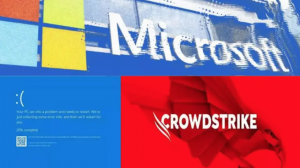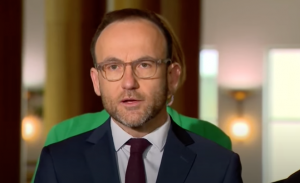Big Tech’s ‘Sinister Agenda’ Behind Getting Kids Hooked on Technology

With babies developing with a tablet in their hands, the next logical step, ostensibly for the sake of everyone’s convenience, is to implant a cellular communications device — yes, a mini mobile phone — in the bodies of our children.
By Paraschiva Florescu and Rob Verkerk Ph.D.
“The surest way to corrupt a youth is to instruct him to hold in higher esteem those who think alike than those who think differently.” — Friedrich Nietzsche
“Tablets should be part of a baby’s world from birth,” claims Professor Annette Karmiloff-Smith, a highly influential developmental and cognitive scientist whose study found that getting your toddler to scroll through a digital tablet actually improves their motor skills.
And — I hear you ask: What about the accompanying risks? Shall we just ignore them? Let’s face it — our kids’ tablets provide such a useful means of keeping the little ones occupied, giving stressed parents a break.
Have you witnessed anything about children and their relationships with technology that makes you uncomfortable, bearing in mind the importance of subconscious programming during the early years of life?
Do they constantly pull their phone out of their pocket during a conversation? Do you see them scrolling, seemingly mindlessly?
What have you witnessed when walking in your local neighborhood: perhaps children with their heads buried in their devices and empty quiet parks?
Whichever way you cut it: family dynamics are changing rapidly as digital technologies take an ever more important role in our lives, and our children’s lives, and, courtesy of social media, human relationships are becoming increasingly virtual.
With babies developing with a tablet in their hands, the next logical step, ostensibly for the sake of everyone’s convenience, is to implant, a cellular communications device — yes, a mini mobile phone — in the bodies of our children.
This technology is a key part of the development of the currently emerging Fourth Industrial Revolution that includes everything from artificial intelligence (AI) to the Internet of things and robotics.
In fact, in case you think this idea is fanciful, it’s given as “Shift 1” in the book of the same name, by none other than Klaus Schwab, the founder of the World Economic Forum (WEF).
Think just how many of today’s teenagers might be up for an implantable mobile device: imagine the convenience! No need to subscribe to any platforms, and they’ll never need to worry again about losing their mobile phone!
Cartoonist Gary Varvel captures our current reality perfectly below.

Mobile phones are becoming an extension of today’s youth. But is there a more sinister agenda unfolding?
How about this for an idea, the first part of which has been borrowed from the playbook of a number of industries, tobacco and opioids, to name just two: create digital addiction or extreme dependence, disconnect humans from each other and from the natural world around them and re-program them in ways that prevent them operating as independent, free-minded citizens and make them compatible with the grand masterplan of the world’s current puppet masters.
In the process, you’ll also be able to surveil their every move via the devices they use to communicate, shop with, bank, drive with, meditate with, recreate with. The mobile device, its associated apps, and its ever-improved camera and recording capabilities have literally become an extension of ourselves.
The notion that dependency or addiction is created on purpose to surveil and control us, is of course just a theory. But disconcertingly, there are a lot of facts along the way that suggest that our dependency on our handsets and computers might be part of a very deliberate plan that leads humanity — at least those that conform — into a transhuman and posthuman future.
This is the future of humanity that the likes of futurist and Google engineer, Ray Kurzweil, historian Yuval Noah Harari, Schwab, and many others in influential positions, are increasingly considering an inevitability. But, like most addictions and psychological re-programming — it is a choice, albeit one that might be difficult for many to avoid.
Defining the problem
Digital or social media addiction can be described as “being excessively concerned about SNSs [social networking sites], motivated by a strong desire to log in to or use SNSs, and devoting so much time and energy to SNSs that it impairs other social activities, studies/job, interpersonal relationships and/or psychological health and wellbeing.”
It’s fair to say that based on this definition, the vast majority of our youth could be considered to be addicted to social media.
The World Health Organization recognizes gaming addiction as a disorder, but not digital addiction (also known as technology overuse) more broadly.
Other studies disagree that digital technologies have a “standalone addictive power” and distinguish between true addictive disorders and negative side effects of social media use.
Even if one disagrees that it is a pathological addiction, just as disconcerting is the development of an extreme dependency on digital technologies to such an extent that a new term, nomophobia, entered the Collins Dictionary, as “a state of distress caused by having no access to or being unable to use one’s mobile phone.”
Whether our youths are addicted or “just” nomophobes, there is a sinister problem here, part of a bigger plan of Big Tech that’s been unfolding for some time.
Watch Paraschiva’s interview with David Charalambous
Paraschiva Florescu recently spoke to David Charalambous, founder of Reaching People and a behavior and communication dynamics expert about the very real issue of digital addiction in young people and how we can combat it. Or listen to the interview here.
Big Tech’s big plan
Nothing that goes on social media platforms, data such as messages, photos, texts, etc. belongs to us anymore. It becomes the property of the platform itself. Data is currently one of the most valuable assets in the world.
The incessant attempts of big corporations to transform everything into data is a form of control.
It’s being used maliciously to feed into AI systems in order to understand our human behavior. How we think, what we buy, how many steps a day we take — all this is valuable information that Big Tech is gathering.
These AI systems are designed to control us.
Our data are also used to inform new developments such as neuromorphic computers, which are artificial “brains,” and “pervasive neurotechnology.”
It might not surprise you that the CEO of SharpBrains, one of the leaders in this field and an allegedly “independent market research firm,” is also on the panel of the WEF’s Council on the Future of Neurotechnology.
Data from social media sites are collected by business owners.
Eighty-six percent of business owners gather data from their customers, with 64% using data from social media sites, mainly Facebook and Instagram.
Our data are used to inform propaganda campaigns from voting to vaccination, as portrayed in the Netflix documentary “The Great Hack.”
Tristan Harris, tech “ethicist” featured in the movie “The Social Dilemma,” (see here and here) suggests in his piece at the Nobel Prize Summit 2023 that social media is about “re-wiring the flows of attention and information in our society.”
Think of it this way: life on this planet has always revolved around an energy exchange of some sort.
A carnivore eats a herbivore, yet the energy of the herbivore’s body returns to the ground to fuel other life forms, including the progeny of the herbivore. The currency of exchange for a beautiful work of art is typically money.
The transaction that occurs is typically regarded as a fair exchange for raw talent, years of experience and hours and hours of attention and creativity expression, a value that can be subsequently traded (recycled).
With social media, the exchange is often very unbalanced. We give to it (attention, time, ideas, creativity) and we get little more than a dopamine hit in return.
It leaves us feeling more empty and unfulfilled, a bit like trying to fill a bottomless bucket, but we go back for more dopamine. We are turning our youth into dopamine junkies.
According to Charalambous:
“The problem is when something looks like it’s going to provide that, but it doesn’t. Now, rather than us stop, what we tend to do is more of it. If somebody doesn’t feel socially accepted, that’s a part of their psyche that’s not fulfilled, they’re going to seek likes.
“The problem is, you know the typical thing on social media when someone likes your post, that will give them a short burst of motivation or enjoyment or pleasure, but it won’t be fulfilling enough because it won’t ever reach that deep part of them.
“So then they’re going to find themselves in that constant cycle. When it comes to adolescents, to be socially accepted is massively important.”
The perspective of big science
The formal science of evaluating the risks and benefits of social media appears to give the impression of balance. Some (see here and here) identify negative consequences of social media such as cyber-bullying, cyber-racism and issues relating to the exchange of sexually explicit content between minors.
Yet many papers deny or ignore any link between depression, anxiety, social disconnection, low self-esteem, poor self-image or body dysmorphic disorder with the amount of time spent on devices.
That’s despite these effects being frequently cited in the popular press, because they are widely observed, being supported by limited studies. On the contrary, the literature (that often in turn reflects the interests that fund research), frequently bigs up the benefits of digital technologies used almost ubiquitously by our youth.
For example, a recent review reminds us that social media is now the “primary mode of peer interactions and communication among adolescents,” this trend has been further magnified by the COVID-19 era.
Another review finds that “social gaming may also increase feelings of connection and sense of community.”
In Indigenous communities, “mobile phones are viewed as an extension of a person and may be shared by family members” whilst “forming community through social media can act as a process of uniting and healing for the Indigenous community,” finds Emma Rice, a researcher at Georgetown University.
Others go as far as saying that isolation in young people is more common among those who are disconnected from digital sources of entertainment and social media.
Yet, does social media offer genuine connection, and is a digital connection equivalent to a real-world connection?
Edward Hallowell, Harvard psychiatrist, writes in his paper about the “human moment” to illustrate meaningful connection as “an authentic psychological encounter that can happen only when two people share the same physical space.”
This might have something to do with our improved perception of non-verbal communication when we are in close proximity to one another.
But it may also be linked to the close interaction of proximal human biofields (the electromagnetic field that radiates beyond every living being). With digital technologies, we can all agree that we have connectivity, but perhaps we don’t experience connectedness.
This is the “Story of Separation” that contemporary thinker and philosopher, Charles Eisenstein, elaborates on in his book, “The More Beautiful World Our Hearts Know Is Possible.”
In this story, we are led to believe that we are “separate individuals in a universe that is separate from you as well … you are a bubble of psychology, a mind (whether brain-based or not) separate from other minds and separate from matter.”
Technology of course is just viewed as a further (and inevitable) separation of ourselves from the natural world, with neurotechnologies and AI increasingly being sold to the youth as the champions in this adventure that we must embrace, not reject.
The way out, back into the light
For those not willing to blindly accept this pre-ordained path created by our technocratic “masters,” solutions are unlikely to be found without shining a bright light into the darkness, upon this seemingly unbreakable bond between young people and digital technologies.
As Gabor Mate, renowned addiction expert, has often said, we have to look, not at why the addiction exists, but why we are driven to it when there is often so much pain, and so little gain.
Young people with poor social relationships and isolation are more likely to abuse social mediaand get addicted.
A lack of real-world friends is the primary driver of extended use of social media, which in turn leads to dependency and potential addiction.
The solution then must lie in changing our environments and cultures in ways that enhance the quality of our lives, helping young people to develop and nurture a strong sense of real-world connectedness.
With each other, and ideally also with the natural world, a relationship that is also strongly related to improved quality of life.
According to Charalambous:
“You’re seeing people more and more unfulfilled and more and more hungry for all the things that we need as a human. We need to feel a part of society, we need to feel like we’re fitting into groups and that we’re socially accepted.
“We need to bond to partners, obviously, social media is causing a lot of problems in that aspect. We need to feel that we’re providing a purpose and we are making an influence on the world. We need to feel safe. It’s about reconnecting back to reality or our perception of it at least.”
As with many addictions, the remedy is often found within the addiction itself and studies are looking at how virtual reality exposure therapy can help treat phobias, high anxiety and addictions.
Phone applications such as Calm or Insight Timer can also potentially help young people cultivate mindfulness.
Runaway technologies could be used as positive tools and various “protocols” can help youths and parents alike change their relationship with technology.
However, the best, easiest and most accessible remedy is, and always will be, found in nature.
In a world that is increasingly trying to transform us into human-machine hybrids, the remedy must lie in developing a higher level of consciousness of our innate humanness.
Building those connections that don’t just trigger a short-term dopamine buzz that needs to be repeated and repeated. But to build a sense of connection and bonding that comes through the release of oxytocin, the love hormone.
Building solid, long-lasting interactions that allow us to build purpose and meaning in our lives. Ultimately allow human transcendence, not posthuman, digital transcendence.
It’s our time to choose and to help bring a wider understanding of the pervasive and potentially destructive nature of digital technologies to those around us, to the youngest members of our families and communities most particularly.
Originally published by Alliance for Natural Health International.
Rob Verkerk, Ph.D., is the founder and executive & scientific director of the Alliance for Natural Health.
Paraschiva Florescu is the mission facilitator of the Alliance for Natural Health International.
The views and opinions expressed in this article are those of the authors and do not necessarily reflect the views of Children’s Health Defense.





